Nulling interferometry
How to optimally design a nulling interferometer's beam combiner ?
Nulling interferometryHow to optimally design a nulling interferometer's beam combiner ? |
 |
Home |
Show content only (no menu, header)Optimal beam combiner design for nulling interferometersSummaryA nulling interferometer design is defined by its aperture geometry (number of apertures, their positions and diameters) and its beam combiner (set of coherent beam combinations performed to produce the interferometer output beam(s)). In this paper, the optimal design of a beam combiner is discussed for the detection and characterization of exoplanets. A scheme to optimally design the coherent beam combinations for any nulling interferometer aperture geometry is presented. The technique relies on Singular Value Decomposition (SVD) of the complex amplitudes at the entrance of the interferometer to concentrate as much starlight in as few coherent outputs as possible. This scheme typically produces several very dark interferometer outputs, achieving simultaneously high null depth and high sensitivity for exoplanet detection and characterization.The analysis presented in this paper results in three fundamental findings:
1. IntroductionSpectral characterization of Earth-like planets around other stars may reveal the presence of life, and is therefore of high scientific value. Acquiring a high quality spectra of small rocky planet in the habitable zone around its host star requires an instrument that can optically separate starlight from planet light in order to avoid being limited by photon noise from the host star. Two approaches have been studied in the last few decades: nulling interferometry with an array of telescopes, and single aperture coronagraphy. A nulling interferometer is an interferometer designed to cancel light from an on-axis source (usually a star) while keeping as much as possible light from faint sources close to the central star. Nulling interferometers can thus detect light from exoplanets [Bracewell 1978] , and are particularly attractive at infrared wavelengths (about 10 μm) for which the planet to star contrast is more favorable than in visible light. At this wavelength, a single aperture (+coronagraph) option would require a large telescope due to the linear dependence of angular resolution with wavelength, and an interferometer consisting of widely separated telescopes is a more suitable approach [Bracewell 1979][Woolf & Angel 1986]. Nulling interferometers with short (few meter) baselines have also been proposed for visible light observations of exoplanets [Shao & Levine 2010]. A key limitation of the two-telescope nulling interferometer proposed by [Bracewell 1978] is due to the finite angular size of stars, which, even in the absence of instrumental defects, makes it impossible to fully cancel starlight while preserving light from a faint nearby source (planet). With a 2-telescope configuration, the ideal nulling interferometer throughput for a point source is proportional to the square of the angular separation to the optical axis: the interferometer produces a second order null near the optical axis, commonly referred to as a θ2 null, where θ is the angular separation to the optical axis. Since stellar diameters are typically about 1 percent of the planet to star separation for a system similar to the Earth-Sun system, the maximum differential attenuation between starlight and planet light attainable with a 2-telescope design is therefore around 1e4, short of the ~1e6 (thermal IR) to ~1e10 (visible light) contrast between the two objects. To overcome this limitation, nulling interferometers with more than two telescopes have been proposed to achieve higher order nulls, thus offering better extinction on partially resolved stellar disks. The extinction is then a function of both the interferometer geometry and the interferometric combination between the telescope beams [Lawson et al. 1999], and many interferometer designs have been proposed, with increasing null depth. The Angel Cross design [Angel 1990] combines for example two Bracewell interferometers in a 2-D geometry to achieve a θ4 null. Angel & Woolf 1997 later showed that a linear 4-aperture design can offer a θ6 null. With 5 telescopes, a solution offering a θ8 deep null was also proposed [Woolf & Angel 1997]. [Leger et al. 1996] and [Mennesson & Mariotti 1997] established array geometry requirements to reach a given nulling order, and proposed a 5-telescopes solution offering a deep null and able to distinguish the signal from a planet from a symetrical exozodiacal cloud. Rouan 2003 shows that arbitrarily deep nulls can be obtained, given a sufficient number of telescopes, and discusses in a later paper [Rouan 2006] the practical usefulness of deep nulls, finding that interferometers with deeper null are more resilient to phase errors. Null depth is unfortunately often achieved at the expense of efficiency: for a fixed number of apertures, a smaller fraction of the total light gathered by the interferometer is used as null depth is increased. For example, in the 4-aperture Angel Cross design, 25% of the light is used (only one of the four interferometer outputs offers the θ4 null depth), while a simpler 2-aperture Bracewell offers 50% throughput with a θ2 null. Null depth and throughput must therefore be balanced to find the optimal interferometer design when total mission cost/complexity are taken into account, and the scientific return of the mission must be maximized. Consequently, the optimal array geometry may not offer a very deep null in order to maintain high throughput, or to adopt an aperture geometry which can be easily realized, such as maintaining all apertures on a circle to avoid long delay lines. For example, the Darwin mission study adopted a 4-aperture geometry on a circle, with a 2nd order null [Cockell et al. 2009], with a 50% efficiency (two of the four interferometer outputs are used for science), and for which stellar leakage is about 100 times brighter than light from an Earth-like planet at 10pc. It is therefore important to understand how the achievable null depth and throughput are constrained by aperture geometry, to simultaneously optimize the aperture geometry and beam combiner design. This interferometer optimization problem however remains largely unsolved, as the development of new nulling interferometers designs has been so far iterative, with no single design method leading to improvements, and no clear understanding of where the performance limits might be, given array geometry constraints. The relative importance of array geometry and beam combiner design is especially unclear, as previously published nulling interferometers designs rely on a particular match between aperture positions and beam combinations to achieve deep nulls, making it impossible to decouple their relative impact on performance. The goal of this paper is to provide a universal method to optimally design the beam combiner for any nulling interferometer geometry, and thus to establish performance limits of nulling interferometry given realistic array constraints (such as maximum number of telescope, or maximum baseline). To achieve this goal, a universal mathematical model of the interferometer is first established and described in section 2. This model is then used in section 3 to derive, for a given entrance aperture geometry, the optimal beam combiner design. Nulling interferometer design examples are given in section 4 to illustrate the findings of this paper. 2. Nulling interferometer model2.1. Relationship with CoronagraphyTraditionally, coronagraphs use single aperture pupil (which may be composed of adjacent segments) and perform starlight rejection with masks introducing amplitude and/or phase in pupil and/or focal planes. Nulling interferometers use a sparse array of telescopes, and perform starlight rejection by coherent destructive interference between the beams. The boundaries between the two techniques have become less clear as several authors have suggested using nulling interferometry schemes on a single aperture (see for example Baudoz et al 2000 and Kotani et al. 2010) or using coronagraphic techniques on sparse apertures [Aime et al. 2001][Guyon & Roddier 2002][Riaud et al 2002]. For this paper, it is assumed that an interferometer is defined by its sparse entrance aperture, while a coronagraph is a nulling device on a single aperture. No distinction is made between the types of nulling devices: coronagraphs using masks in pupil and focal planes, or nulling interferometers using coherent combinations of a finite set of beams. In an earlier publication [Guyon et al. 2006] , the fundamental limits of coronagraph performance for high contrast imaging were derived using a model of the coronagraph akin to a nulling interferometer. The telescope entrance pupil was split into a set of subapertures, which were coherently combined to produce output beams simultaneously achieving high starlight rejection and good transmission for planet light. This approach is justified by linearity in complex amplitude for both coronagraphs and interferometers, which leads to equivalence between the two approaches: for a finite field of view, a coronagraph can be modeled as a set of coherent interferences between a finite set of subpupils paving the telescope entrance aperture. Thanks to this equivalence, a universal algebraic representation of nulling devices (including coronagraphs) could be used to derive the fundamental limits of coronagraphy, using linearity in complex amplitude as the only constraint to the performance. The approach used in Guyon et al. 2006 is therefore equally applicable to both coronagraphs (nulling device on a single aperture) and interferometers (nulling device on sparse aperture). When this approach is used on sparse apertures, as done in this paper, it can directly give, for a given aperture geometry, the optimal design for the nulling device: which beams should be coherently mixed together, with the corresponding mixing ratios and phase shifts. In Section 2.2, this algebraic modeling approach, first proposed in Guyon et al. 2006 , is described and adapted to sparse apertures. 2.2. Nulling interferometer algebraic representation
| |||||||||||||||||||||||||||||||||||||||||||||||||||||||||||||
| Vk = rk ei 2 π (xk α + yk β)/λ | (2.1) |
|---|
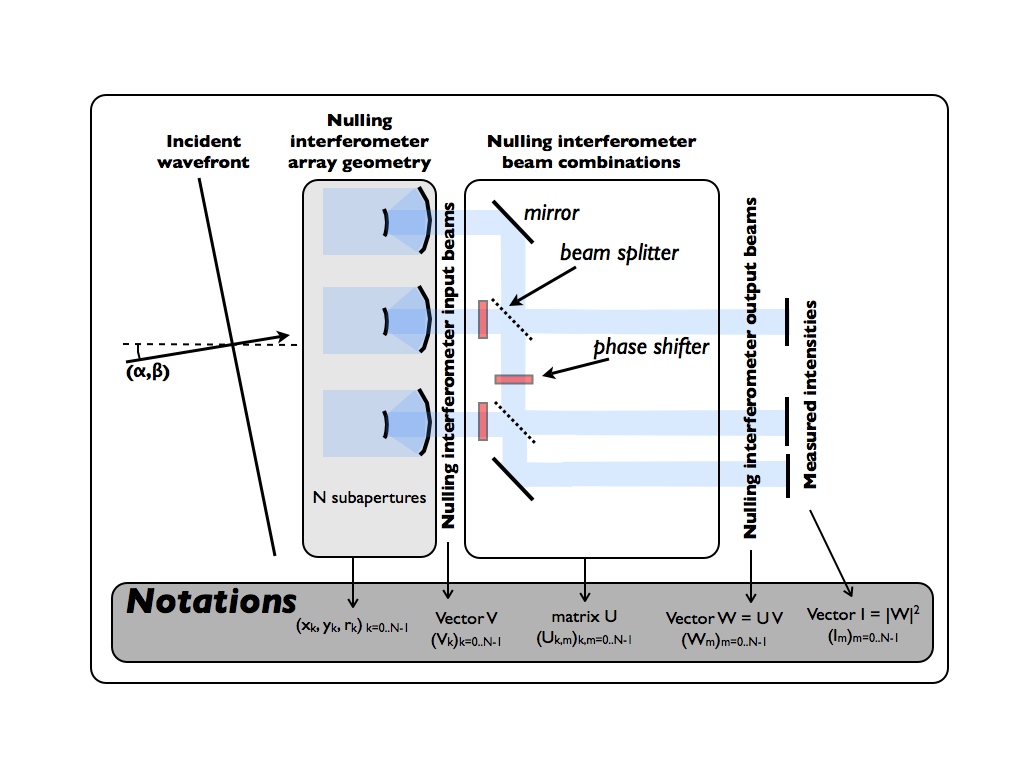 |
Fig 1: Notations used. The indices used for the inputs and outputs of the interferometer's beam combination unit are n and m respectively.
[jpg]
|
| W = U V | (2.2) |
|---|
The science detector measures the square modulus I = |W|2 of W. The matrix U represents the design of the nulling device, and is not a function of the input complex amplitudes V. Coefficients of U are complex numbers noted Uk,m, with k the subaperture index and m the interferometer output index. Each line Um of U (m fixed) records the set of input complex amplitudes which, when "fed" into the interferometer, will send all of the light into interferometer output m. Since this set of inputs can generally not be written as a vector V according to equation (2.1), there may not be a position on the sky for which all light would be directed to output m (although one might choose the matrix U to send all light from a given sky position (α,β) to a single output m by setting Um=V(α,β)). Each column Uk of U records how light from a single input k (a single subaperture) is directed to all outputs.
Since |V|2 = |W|2 for any input vector V (the interferometric combinations preserve total flux), U is a complex unitary matrix .
The nulling device representation adopted in this study is universal, as the matrix U can describe any coherent mixing scheme between the beams. Any matrix U can be implemented by finite numbers of beam splitters and phase shifters, but the model is not restricted to specific phase shifts or split ratios between beams, as previous studies have sometimes assumed (for example, the Laurance nulling interferometers described in Karlsson & Mennesson 2000 are limited to 0 or π phase shifts).
The approach to designing an optimal interferometer, detailed in this section, is to concentrate as much starlight as possible in as few interferometer outputs as possible, therefore leaving other outputs sufficiently dark for detection of high contrast source(s). More specifically, the optimal set of interferometric combinations between the interferometer input beams is iteratively built by first directing as much of the starlight as possible in a single coherent output, therefore minimizing the total amount of starlight in all other outputs. The beam combinations between the remaining outputs are then optimized to maximize residual starlight is a single coherent output, and so on. This iterative approach ensures that, provided that the interferometer output beams are ranked in decreasing order with amount of residual starlight, the amount of starlight in each output is optimally minimal. The resulting interferometer design will maximize planet detection SNR, as it will provide as many nulled outputs as possible, therefore simultaneously optimizing null depth and throughput. This approach is different from only optimizing null depth, which may lead to a design for which a single output is nulled while all other outputs retain a significant amount of starlight - a solution which would offer a low efficiency for planet detection. Another advantage of this approach is that the optimal nulling device design (matrix U) is largely independent of target parameters (value of stellar angular size, planet to star position or contrast), and is only a function of the array geometry, as discussed in this section.
If the central source is partially resolved, it is no longer described as a single vector V, but as a set of NBpt vectors Vpt = V(αpt,βpt) with αpt and βpt (pt = 0 .. NBpt-1) uniformly distributed over the stellar radius. The measured intensities at the output of the interferometer are obtained by summing incoherently the intensity vectors for each of the points on the stellar surface.
| I(star) = (1/NBpt) x ∑pt=0..NBptIpt = (1/NBpt) x ∑pt=0..NBpt |U V(αpt,βpt)|2 | (3.1) |
|---|
Mathematically, the operations described above is a Principal Components Analysis (PCA), which can be performed by singular value decomposition of the NBpt-by-N transpose A of the data matrix AT. A is composed of the vectors Vpt (each column pt of the matrix A is the vector Vpt=V(αpt,βpt)):
| A = U Σ B* | (3.2a) |
|---|
| YT = AT U | (3.2b) |
|---|
The SVD operation described above identifies and sorts the dominant "modes" Um (m=0..N-1) present in the set of NBpt vectors Vpt used to model the star, and builds the interferometric combinations which link each of these modes to a single output of the interferometer. The first mode Um=0 is equal to the vector V(0,0) and has a singular value close to 1 (strictly equal to 1 if the star has a radius rs = 0), and subsequent singular values are much smaller unless rs becomes comparable to the interferometer's diffraction limit.
In a randomly chosen 2-D interferometer with a stellar size smaller than the interferometer's diffraction limit, the second and third modes are 2nd order modes of stellar size: their intensity (square of amplitude) contribution to a vector V(α,β) increases as a linear combination of α2 and β2. The next 3 modes are 4rth order, and the following 4 modes are 6th order.
This property is a direct consequence of the Taylor expansion of equation (2.1):
| ei(αx+βy) = 1 + iαx + iβy - (1/2)(α2x2 + 2αβxy + β2y2) - (i/6)(α3x3 - 3α2βx2y - 3αβ2xy2 - β3y3) + .... | (3.3) |
|---|
PREDICTION 1: In a 2-D interferometer of N subapertures, the minimum achievable null depth γ is γ=2 for N=2,3, γ=4 for N=4,5,6, γ=6 for N=7,8,9,10. For any aperture geometry, there exists a coherent mixing of the beams that will reach this null depth using a finite number of beam splitters and phase shifters.
The proof for this prediction is given in section 3.3., where it is shown that a SVD decomposition can be used to design the interferometer nulling device reaching the null depth stated above. The performance of 2-D nulling interferometers is therefore not a smooth function of number of apertures N when performance is limited by stellar angular size. Increasing the number of apertures from N=5 to N=6 does not bring a large increase in performance, while going from N=6 to N=7 does by allowing a 6-th order null.
PREDICTION 2: For the same number of apertures N equal or greater than 3, 1-D interferometers can reach deeper null than 2-D interferometers.
The analysis in section 3.3 shows that at high contrast, the key to designing a high sensitivity interferometer with a limited number of apertures is to remove the number of relevant low order terms (=make the coefficient in front of the term very small) in equation (3.3) to rapidly gain access to higher order modes without having to increase the number of subapertures. This can best be done with a 1-D interferometer, where the Taylor expansion becomes:
| ei(αx) = 1 + iαx - α2x2/2 - iα3x3/6 + .... | (3.4) |
|---|
Previously published interferometer designs illustrate the fundamental advantage of 1-D arrays for null depth, and many previously suggested interferometer designs reach the minimum achievable null depth shown in table 1. The Angel Cross design [Angel 1990] is a 2-D geometry to achieving a θ4 null, while a linear array with the same number of apertures can offer a θ6 [ Angel & Woolf 1997 ]. The 2-D 6-aperture Mariotti configuration [Mennesson et al. 2005] achieves a θ4 null. Collapsing the 4-aperture 2-D Angel cross geometry into a 3-aperture 1-D array yields the degenerate Angel cross, with a θ4 null. The best reported null depth with small number of apertures are indeed 1-D geometries, and reach the limits shown in table 1: θ6 null with 4 apertures [ Angel & Woolf 1997 ] and θ8 null with 5 apertures [Woolf & Angel 1997].
Rouan 2006 proposes a method to design 1-D nulling interferometer designs offering a θ2L null with 2L apertures. The iterative method employed to do so is simple and showed for the first time that arbitrarily deep nulls can be achieved given a sufficient number of apertures. As shown by table 1, it is however not optimal, as a θ2L null can be obtained with any set of L+1 apertures.
| Number of apertures | Minimum Null order | |
|---|---|---|
| 1D | 2D | |
| 2 | 2 | 2 |
| 3 | 4 | 2 |
| 4 | 6 | 4 |
| 5 | 8 | 4 |
| 6 | 10 | 4 |
| 7 | 12 | 6 |
| 8 | 14 | 6 |
| 9 | 16 | 6 |
| 10 | 18 | 6 |
PREDICTION 3: Interferometer effective throughput increases with number of apertures
The analysis presented in section 3.3. can also predict the sensitivity of interferometers for high contrast observations. For example, if a given observation requires a θ4 null, and a 5-aperture 1-D interferometer is used, then at most 3 out of 5 beam outputs can be used toward detection, yielding an effective throughput (averaged over all positions of the planet relative to the interferometer pointing) of 60%. In this example, the optimal 5-aperture interferometer will have one bright output (where most of the starlight is directed) and one second-order null output, with all remaining outputs being θ4 or deeper.PREDICTION 4: The optimal nulling coherent beam combiner only uses phase shifts equals to 0 and π
As discussed in section 3.3, in the small stellar size limit, the Eigenvectors which represent the contribution of complex amplitudes at the entrance of the interferometer to its outputs match the terms of the Taylor expansion in equation (3.3). For example, the term in α, which should be used to construct a second-order null output, is the vector [ixk], where xk is the x-coordinate of aperture number k. Equation 3.3 shows that all terms of the expansion are in the form (in)Vr, where i=sqrt(-1), n is an integer, and Vr is a vector of real numbers (this is due to fact that the spatial coordinates x and y are real numbers). Alternatively, each of the eigenvector can be written as eiφ Vr, where φ is 0 or π/2. The overall phase of the eigenvector has no effect on the beam combiner design, as the intensity output of the interferometer for the set of complex amplitudes eiφ Vr at the entrance of the interferometer is independent of φ. In fact, when mathematically performing the SVD to identify eigenvectors, pairs of eigenvectors are produced with identical amplitudes and a π/2 phase offset between the two vectors. Since the two vectors in each pair are physically identical for the interferometer, only one of the two is kept toward designing the nulling interferometer, and its phase can arbitrarily be chosen such that the eigenvector is real. A positive real coefficient in the vector means that the light is not phase-shifted between the input and output, while negative coefficients indicate a π phase shift. This prediction is numerically verified by the analysis in this paper, as the optimal nuller design (matrix U) is always real. Phases are therefore omitted in the matrix U notations in the rest of the paper, and a sign "-" is used for a π phase shift. 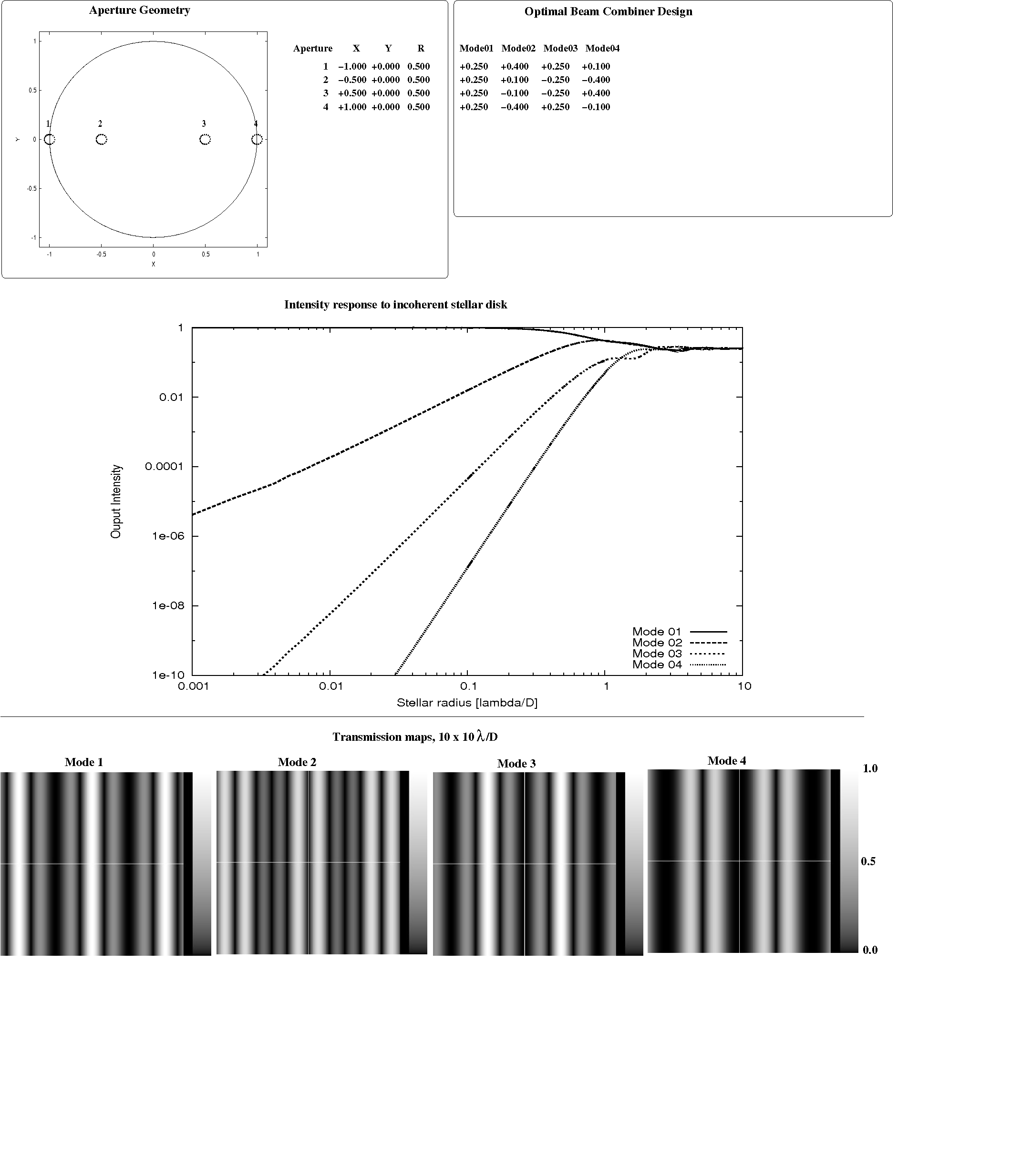 |
Fig 4.1: Beam combiner solution for the linear 4-aperture geometry proposed in Angel & Woolf 1997. The aperture geometry is shown in the upper left. The optimal beam combiner design, as obtained by the SVD approach described in this paper is shown in the upper right table, where each column corresponds to one interferometer output, and the coefficients of the table show how each aperture (lines of the table) is split between the outputs. The element (i,j) of the table indicates the fraction of the intensity collected by aperture (i) that is directed to interferometer output (j), and a negative value indicates a π phase shift. The distribution of light intensity among the four outputs for the observation of an incoherent stellar disk is shown in the plot at the center of the figure, as a function of stellar angular radius (x-axis). The intensity transmission map for each of the four interferometer outputs is shown in the lower part of the figure.
[eps] |
The first output of the interferometer (Mode 1 in figure 4.1) contains most of the starlight, while modes 2, 3 and 4 show respectively θ2, θ4, and θ6 intensity dependence with stellar angular size. The ability to produce a 6th order null with this 4-aperture geometry, first described by Angel & Woolf 1997, is thus confirmed by the SVD analysis. The beam combinations that produce this deep null, as given by the SVD (last column of the table at the upper right of figure 1) also match the combination identified by Angel and Woolf: the dark output of the inner 2-aperture Bracewell interferometer (apertures 2 and 3, coefficients -0.4, 0.4) is combined with the dark output of the outer Bracewell interferometer (apertures 1 and 4, coefficients 0.1, -0.1). As Angel and Woolf described, the two Bracewell interferometers have opposite signs, and the inner interferometer is given 4 times (2 times in amplitude) the weight of the the outer interferometer. The solution given by the SVD analysis offers superior sensitivity to the beam combiner design proposed in Angel & Woolf 1997 , as it also offers a θ2 null (output 2) and a θ4 null (output 3), while the beam combining configuration proposed in Angel & Woolf 1997 offered two bright outputs (O1 and O2 in fig 1 of their paper) and a single θ2 output (O3 in fig 1 of their paper). This could be achieved by recombining together outputs O1, O2 and O3 of the beam combiner shown in fig 1 of Angel & Woolf 1997 according to the values given in the table at the upper right of figure 4.1.
Angel & Woolf 1997 suggested sightly increasing the amplitude of the outer Bracewell pair relative to the inner pair to achieve a wider null, suggesting a 0.504 relative ratio in amplitude (as opposed to 0.5 in the design described above). The effect of doing so on the null depth is shown in fig 2 of their paper, where three local minima in output intensity are shown within the null, located at approximately -0.1 λ/B, 0 and +0.1 λ/B. To explore this possibility, the SVD analysis is repeated on the same interferometer geometry, but with an 0.1 λ/B stellar radius. Results, shown in figure 4.2., not only confirm that increasing the relative weight of the outer apertures increases null depth, but demonstrate that doing so is the optimal solution to the nulling beam combiner design. The optimal value for the relative weight in amplitude should be sqrt(0.10097/0.39903) = 0.503 for a 0.1 λ/B radius stellar disk, close to the 0.504 value proposed by Angel & Woolf, and the transmission map has 3 local minima at -0.8 λ/B, 0 and +0.8 λ/B, as shown by the local minimum of the intensity output curve vs. stellar diameter for mode 4 in figure 4.2.
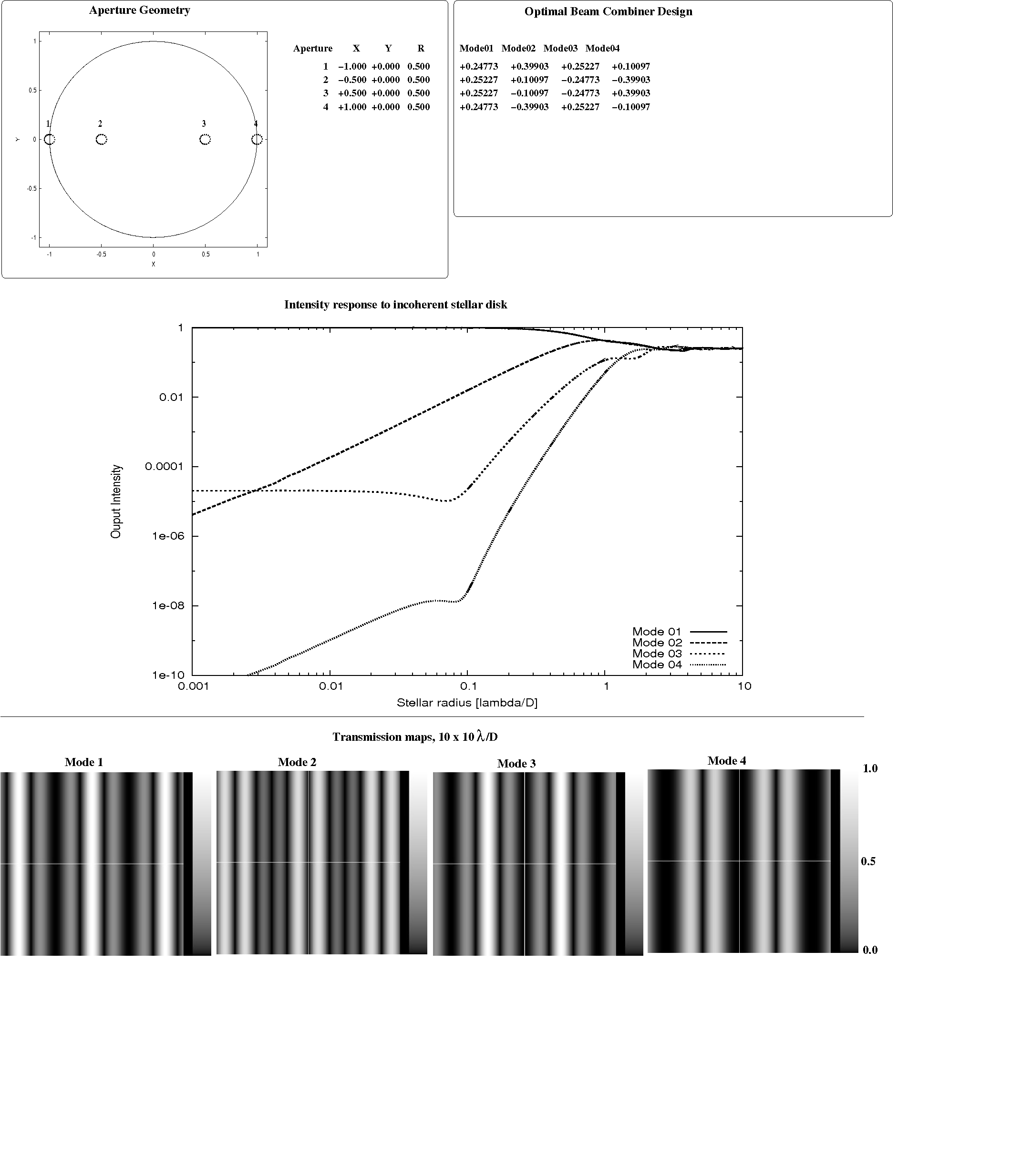 |
Fig 4.2: Optimal beam combiner solution for the linear 4-aperture geometry proposed in Angel & Woolf 1997, computed here for a 0.1 λ/B stellar radius. The solution differs from the small stellar size limit (figure 4.1) in the same way as predicted in Angel & Woolf 1997: more weight should be given to outer apertures in the deepest null output.
[eps] |
A key result of the SVD-based construction of optimal beam combiners for nulling interferometers is the ability to produce deep nulls regardless of aperture geometry. The technique predicts for example that θ6 and θ8 nulls can be constructed out of respectively any 4-aperture linear array and any 5-aperture linear array.
Figure 4.3 shows the result of the SVD-based technique for a randomly chosen 5-aperture linear array geometry. The θ8 deep null produced is especially resilient to stellar angular size and pointing errors: its transmission for a 0.1 λ/B radius disk is below 1e-10. For this randomly chosen geometry, the beam mixing ratios producing the deep null are non-trivial values, with no recognizable integer ratio between the contributions of entrance apertures. The optimal solution also offers other nulled outputs, with nulled orders of respectively 2, 4 and 6, in agreement with the small stellar size limit analysis presented in section 3.
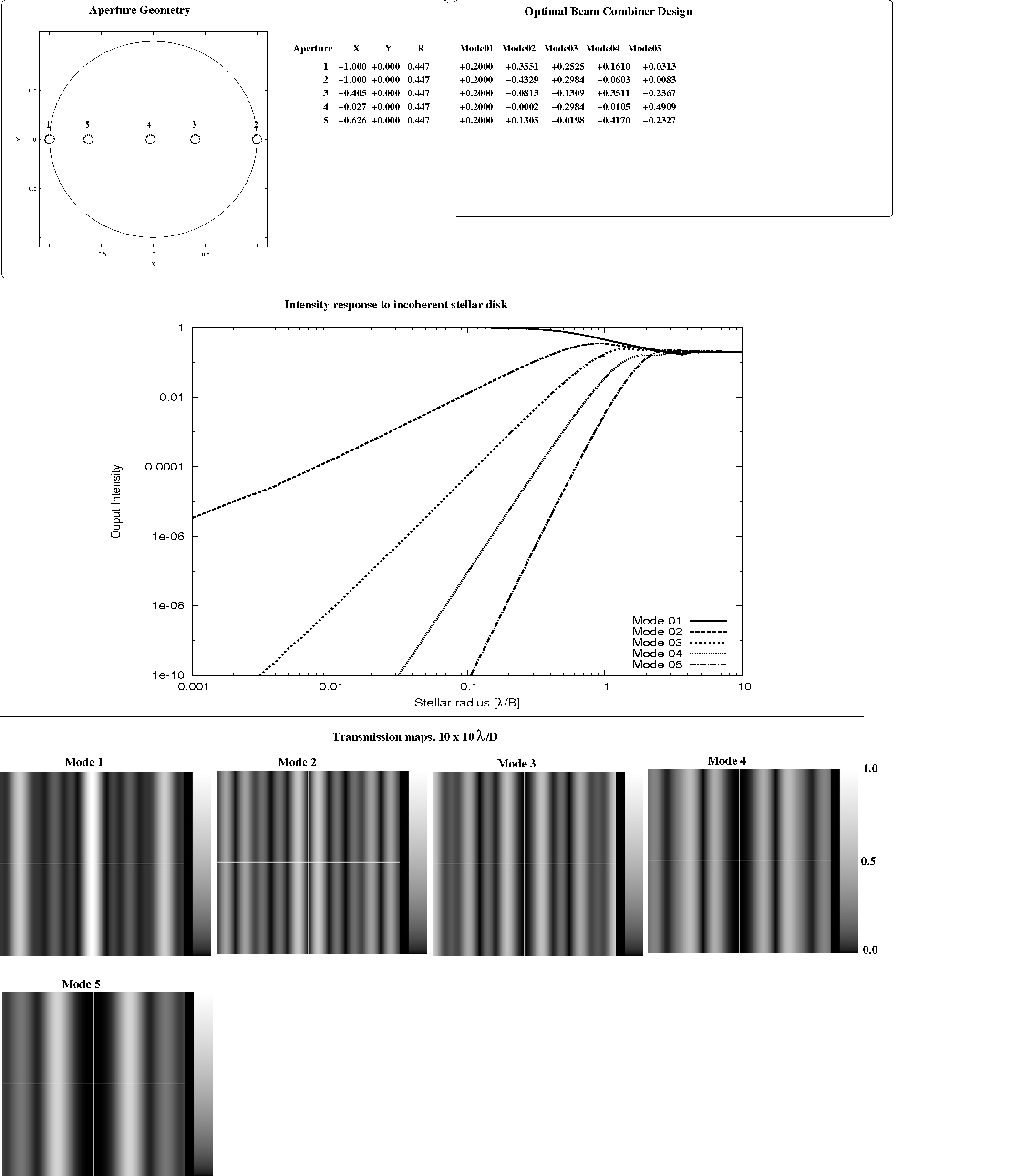 |
Fig 4.3: Optimal beam combiner solution for a randomly chosen linear 5-aperture geometry, computed here for a 0.001 λ/B stellar radius. As predicted in section 3, the solution produces an output with a deep θ8 null, along with 3 other nulled outputs offering θ6, θ4 and θ2 deep nulls.
[eps] |
The ability to produce deep nulls regardless of aperture geometry allows high performance nulling interferometry to be carried on an array geometry optimized for (u,v) plane coverage. Figure 4.4 shows the array geometry and beam combiner design for a 4-aperture array optimized for single-dimension (u,v) plane coverage. The baselines covered by this array are all the (kB/6), with k=1..6, allowing excellent (u,v) plane coverage if the array is rotated around the line of sight. The SVD-based technique does produce a θ6 deep null, along with two other nulls of order 2 and 4 respectively.
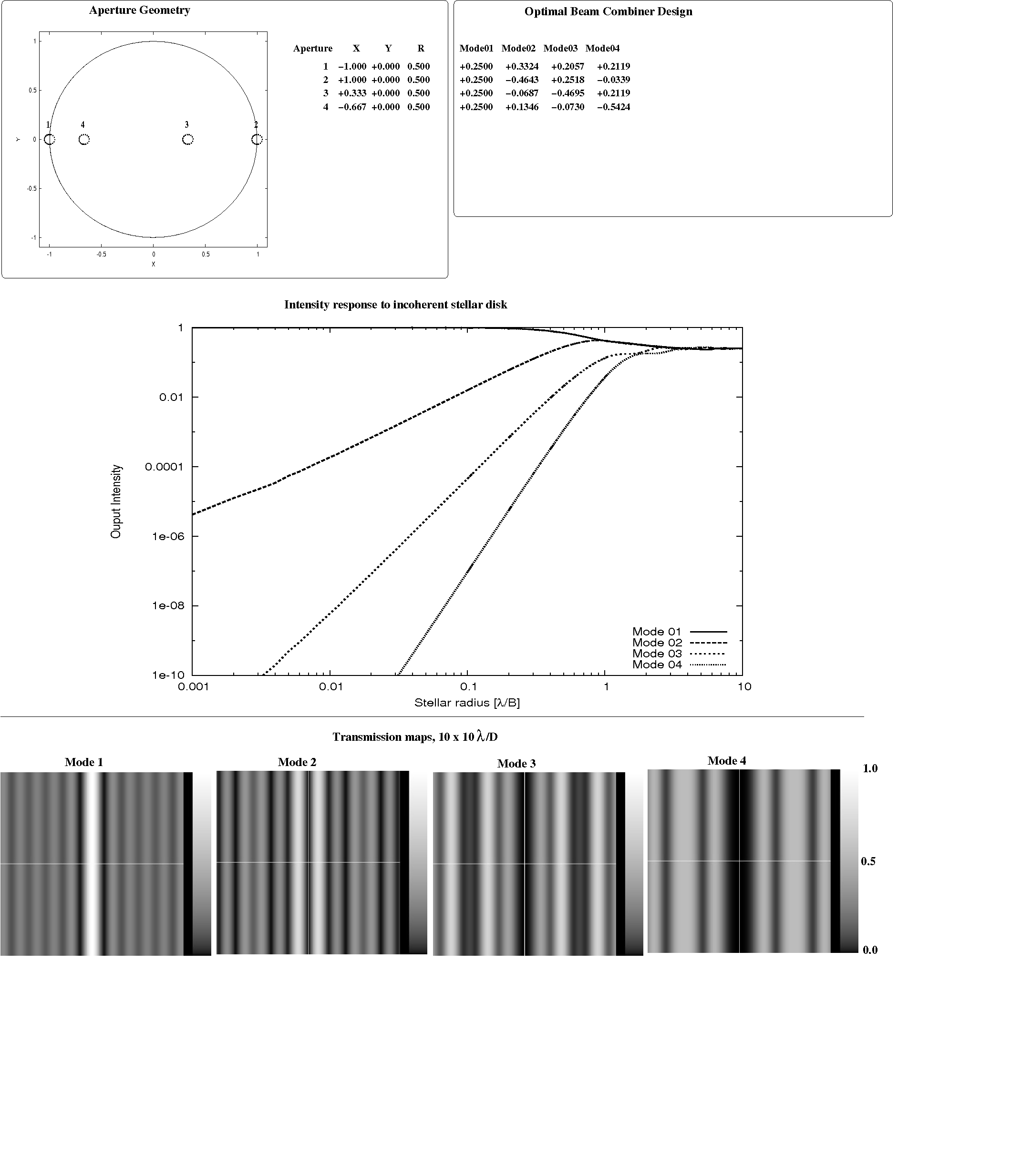 |
Fig 4.4: Optimal beam combiner solution for a linear 4-aperture array geometry optimized for (u,v) plane coverage, computed here for a 0.001 λ/B stellar radius. As predicted in section 3, the solution produces an output with a deep θ6 null, along with 2 other nulled outputs offering θ4 and θ2 deep nulls.
[eps] |
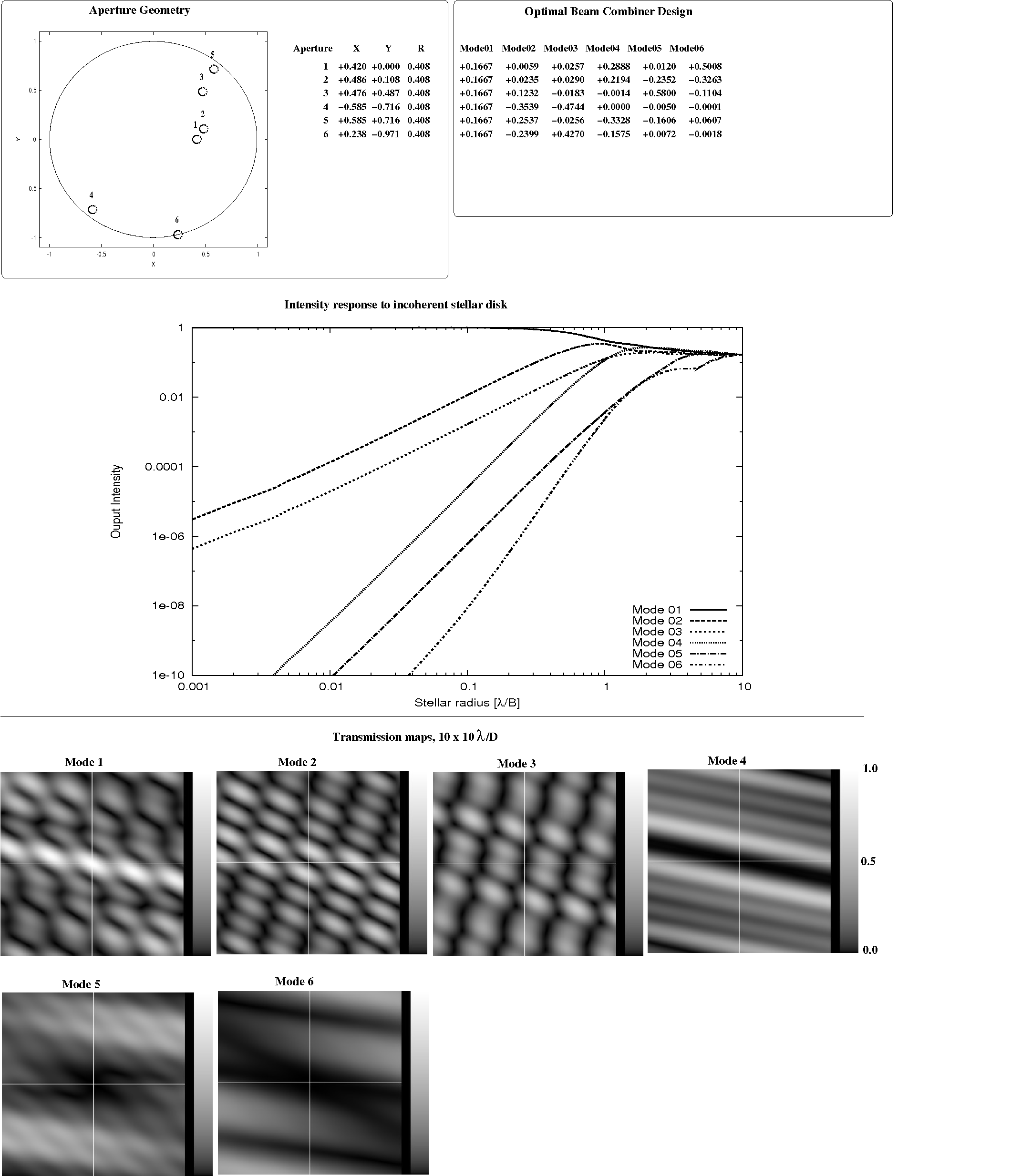 |
Fig 4.5: Optimal beam combiner solution for a 2-D 6-aperture array geometry optimized for (u,v) plane coverage, computed here for a 0.001 λ/B stellar radius. As predicted in section 3, the solution produces three outputs with a deep θ4 null, along with 2 other nulled outputs offering θ2 deep nulls.
[eps] |
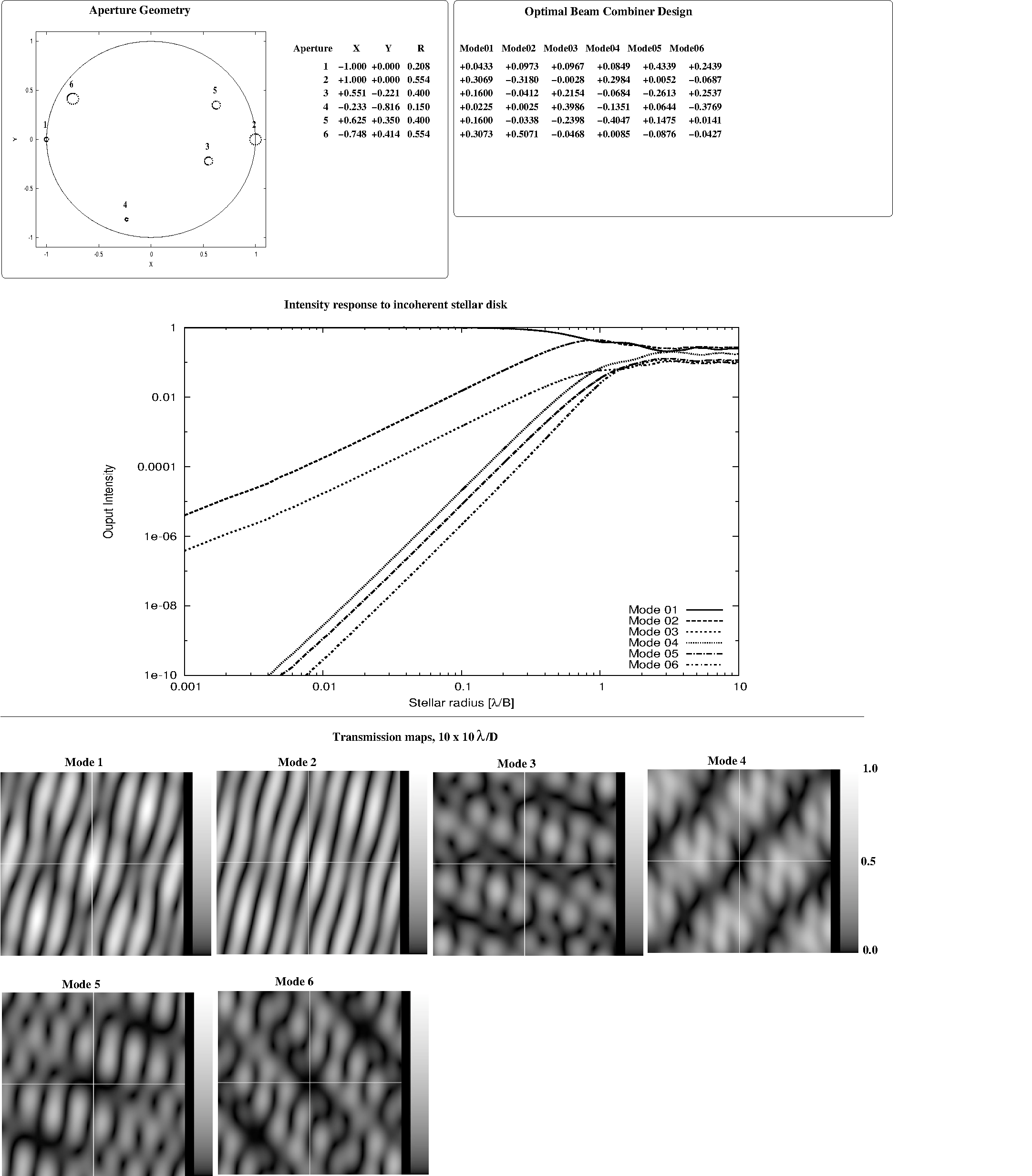 |
Fig 4.6: Optimal beam combiner solution for a 6-aperture array geometry for which the subaperture positions and sizes were randomly chosen. The solution was computed for a 0.001 λ/B stellar radius. As predicted in section 3, the solution produces three outputs with a deep θ4 null, along with 2 other nulled outputs offering θ2 deep nulls.
[eps] |
The analysis performed in this paper shows that null depth in a nulling interferometer is primarily a function of the number of apertures, and that nulls of sufficient depth to detect and characterize exoplanets can be achieved with relatively small number of apertures (4 to 10), regardless of geometry. The superiority of 1-D arrays for achieving deep nulls with a small number of apertures, a trend that is strongly supported by previously published nulling interferometer designs, has been demonstrated and quantified. The SVD-based approach introduced in this paper allows optimal design of beam combiners for nulling interferometry, and is highly flexible, as it can be applied to any geometry, and can also optimally take into account stellar angular size.
While the SVD-based technique has been used to derive the minimal null depth achievable as a function of number of apertures, no strict limit has been placed on the maximum null depth achievable as a function of number of apertures. Specific array geometries may allow deeper nulls than the lower limits shown in table 1, which would enable cost-effective nulling interferometer consisting of very few apertures to be implemented for imaging and spectral characterization of exoplanets.
While the beam combining design in this paper are entirely driven by null depth for a finite stellar angular size, additional considerations must be taken into account in the design of a nulling interferometer, such as sensitivity to background light (especially important at long wavelength, for which zodiacal background exceeds planet light contribution), imaging performance, and resilience to cophasing errors. The impact of exozodiacal light was not considered in this study, but may also drive the optimal array geometry [Defrere et al 2010] and beam combining scheme. These additional constraints should be combined into the SVD-based analysis presented in this paper.